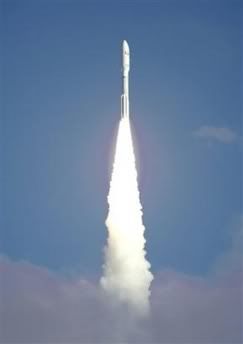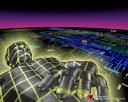NASA Pluto Mission
NASA Launches First Mission to Pluto
By MIKE SCHNEIDER, Associated Press Writer 2:45 PM Thursday January 19, 2006>
 A piano-sized spacecraft blasted off Thursday on a 3-billion mile journey to study Pluto, the solar system's last unexplored planet, and examine a mysterious zone of icy objects at the outer edges of the planetary system.
A piano-sized spacecraft blasted off Thursday on a 3-billion mile journey to study Pluto, the solar system's last unexplored planet, and examine a mysterious zone of icy objects at the outer edges of the planetary system.The New Horizons probe lifted off from the Cape Canaveral Air Force Station at 2 p.m., quickly reaching speeds of 36,000 mph, nearly 100 times faster than a jetliner.
"We have ignition and liftoff of NASA's New Horizons spacecraft on a decade long voyage to visit the planet Pluto and then beyond," said NASA commentator Bruce Buckingham.
It was the swiftest spacecraft ever launched and was expected to reach Earth's moon in nine hours and Jupiter in just over a year.
The distance involved means scientists won't be able to receive data on Pluto until at least July 2015, the earliest the mission is expected to arrive.
After two delays — first because of strong winds Tuesday at the launch pad, and then because of a power outage Wednesday at the spacecraft's control center in Maryland — New Horizons got off the ground.
"It looked beautiful," said Ralph McNutt Jr. of the Johns Hopkins University of Applied Physics Laboratory, one of the mission scientists. "I was getting a little bit antsy."
The launch drew attention from opponents of nuclear power because the spacecraft is powered by 24 pounds of plutonium, whose natural radioactive decay will generate electricity for the probe's instruments.
NASA and the Department of Energy had estimated the probability of a launch accident that could release plutonium at 1 in 350. As a precaution, the agencies brought in 16 mobile field teams that can detect radiation and 33 air samplers and monitors.
A successful journey to Pluto would complete an exploration of the planets started by NASA in the early 1960s with unmanned missions to observe Mars, Mercury and Venus.
Pluto is the only planet discovered by a U.S. citizen, though some astronomers dispute Pluto's right to be called a planet. It is an oddball icy dwarf unlike the rocky planets of Mercury, Venus, Earth and Mars and the gaseous planets of Jupiter, Saturn, Uranus and Neptune.
Pluto is the brightest body in a zone of the solar system known as the Kuiper Belt, which is made up of thousands of icy, rocky objects including tiny planets whose development was stunted by unknown causes. Scientists believe studying those "planetary embryos" can help them understand how planets were formed.
The New Horizons spacecraft was launched on an Atlas V rocket, NASA's most powerful launch vehicle. Some NASA safety managers had raised concerns about the rocket's fuel tank since a similar test tank failed a factory pressure evaluation. The decision was made to fly since the flight tank was in pristine condition and had no signs of any defects like the ones found on the test tank.

















<< Home